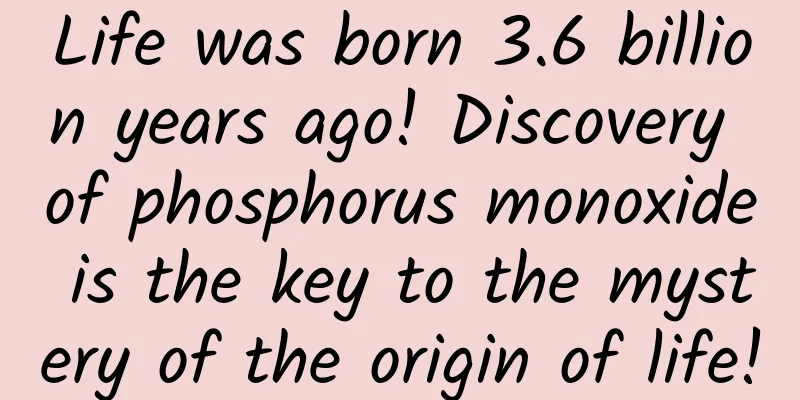Life was born 3.6 billion years ago! Discovery of phosphorus monoxide is the key to the mystery of the origin of life!

|
As you know, phosphorus is found in DNA and cell membranes and is an essential element for life. But how did phosphorus get to the early Earth? This is something of a mystery. Astronomers have now used the combined capabilities of ALMA and the European Space Agency's Rosetta probe to trace phosphorus' journey from star-forming regions to comets. The study shows for the first time where molecules containing phosphorus were formed, how this element was carried in comets, and how specific molecules played a key role in the beginning of life on our planet. The results of the study are published in the Monthly Notices of the Royal Astronomical Society. "Life began on Earth about 3.6 billion years ago, but we still don't know what processes made it possible," said Víctor Rivila, lead author of the new study. New results from the Atacama Large Millimeter/submillimeter Array (ALMA), a collaboration between the European Southern Observatory (ESO), and the ROSINA instrument on Rosetta show that phosphorus monoxide is a key part of the puzzle of the origin of life. With ALMA, which allows detailed observations of the star-forming region AFGL 5142, astronomers can pinpoint the locations where phosphorus-containing molecules like phosphorus monoxide were formed. New stars and planetary systems appear in cloud-like regions of gas and dust between stars, making these interstellar clouds an ideal place to start the search for the building blocks of life. ALMA's observations show that molecules containing phosphorus are produced when massive stars form. Gas ejected from young massive stars opens up cavities in interstellar clouds, and molecules containing phosphorus form on the cavity walls through the combined effects of shocks and radiation from the infant stars. The astronomers also found that phosphorus monoxide is the most abundant phosphorus-containing molecule in the cavity walls. After searching for this molecule in star-forming regions with ALMA, the European team went on to study an object in the Solar System: The idea is to follow the trail of these phosphorus-containing compounds. If the cavity walls collapse to form a star, especially a less massive star like our sun, phosphorus monoxide could freeze and become trapped in icy dust grains around the new star. Even before a star is fully formed, these dust grains clumped together to form pebbles, rocks, and eventually comets, which serve as transporters of phosphorus monoxide. Rosina, which stands for Rosetta Orbiter Spectrometer for Ion and Neutral Analysis, collected data on 67P during the two years that Rosetta orbited the comet. Astronomers had previously found signs of phosphorus in ROSINA data, but didn't know what molecule had carried it there. Kathrin Altwegg, ROSINA's principal investigator and one of the authors of the new study, found a clue to what this molecule might be during a meeting with an astronomer who studies star-forming regions with ALMA: "She said phosphorus monoxide was a very likely candidate, so I went back to our data and found it!" Finding phosphorus monoxide in a comet for the first time helps astronomers make connections between star-forming regions all the way to Earth. "The combined data from ALMA and ROSINA reveal the existence of a chemical thread throughout the process of star formation, in which phosphorus monoxide plays a leading role," said Michele Rivera, a researcher at the Arcetri Astrophysical Observatory of the Italian National Institute for Astrophysics (INAF). "Phosphorus is essential for life as we know it, and since comets most likely delivered large amounts of organic compounds to Earth, the discovery of phosphorus monoxide in comet 67P could strengthen the link between comets and life on Earth. This intriguing journey could be documented thanks to collaborative efforts between astronomers." The detection of phosphorus monoxide is clearly thanks to the interdisciplinary collaboration between telescopes on Earth and instruments in space. Leonardo Testi, ESO astronomer and ALMA European Operations Manager, concludes: "Understanding our cosmic origins, including how common chemical conditions favourable for the emergence of life are, is a major topic in modern astrophysics. ESO and ALMA focus on observing molecules in distant young planetary systems, while ESA missions like Rosetta allow us to directly explore the chemical inventory within our Solar System. The synergy between world-leading ground-based and space-based facilities is a strong asset, thanks to this collaboration between ESO and ESA." Bokeyuan|www.bokeyuan.net Bo Ke Yuan | Research/From: European Southern Observatory Reference journals: arXiv, Monthly Notices of the Royal Astronomical Society Cite: arXiv:1911.11647 BoKeYuan|Science, technology, research, popular science |
<<: How was the deepest well on land in Asia created?
Recommend
The efficacy and function of eggplant leaves
Many people are not very clear about eggplant lea...
The terrifying bird inherited the "legacy" of the dinosaurs!
In today's South America, there lives a stran...
Why does the Earth have an atmosphere? How was the Earth's atmosphere formed?
Produced by: Science Popularization China Author:...
When people eat grains, they always have to deal with “emissions”… How to “puff puff puff” elegantly?
When people eat grains, they always have to deal ...
Is it better to have more or less Panax notoginseng heads?
Is it better to have more or less Panax notoginse...
The efficacy and function of argali testicles
Do you know what argali testicles are? If you kno...
Wrong "light diet" may lead to dementia! What doctors mean by "light diet" is actually...
I believe everyone is familiar with this scene in...
The Webb telescope, which has been repeatedly delayed in its launch, is finally about to be launched into space. Will it become another astronomical legend?
The full name of the Webb Telescope is James Webb...
The efficacy and function of walking alone for thousands of miles
Traditional Chinese medicine culture is profound ...
Japan's Tourism Industry - Who is choosing package tours?
Organizing a trip can be a stressful affair. Ther...
The efficacy and function of Dianhai Narcissus
Dianhai daffodil is a common Chinese medicinal ma...
The efficacy and function of spider incense
Spider incense is a medicinal material. If we hav...
The efficacy and function of rock pepper grass
I wonder if you have ever heard of rock peperomia...









